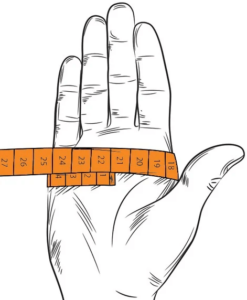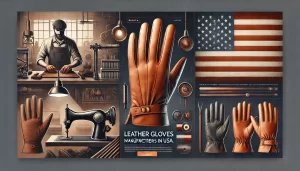Are you tired of gloves that don’t fit right? This can make things harder or less comfortable. To find the perfect glove, you need to know your hand size. We’ll show you how to measure hand for gloves and pick the right size for comfort and function.
Key Takeaways
- Proper hand measurement is crucial for achieving the best glove fit.
- Measuring both hand circumference and finger length is essential for accurate sizing.
- Glove sizes vary across brands, so understanding conversion charts is key.
- Choosing the right glove size can enhance performance, dexterity, and comfort.
- Considering hand variations and activity-specific needs can further optimize the fit.
Learn how to find the perfect glove fit with our guide. Get the best hand protection and dexterity for work, sports, or daily life. Start your journey to the ultimate glove fit, tailored just for you.
How to Measure Your Hand for Gloves
1. How to Measure Hand for Gloves: Step-by-Step Guide
To ensure your gloves fit perfectly, start by measuring the most important parts of your hand:
Step 1: Measure the circumference of your dominant hand’s palm.
- Use a flexible measuring tape and wrap it around the widest part of your palm, just below your knuckles (exclude your thumb). This will give you the circumference measurement in inches or centimeters.
- If you don’t have a measuring tape, you can use a string and then measure the length with a ruler.

Step 2: Measure the length of your hand.
- Measure from the tip of your longest finger to the base of your palm (where your wrist begins). This will give you the length of your hand in inches or centimeters.
Step 3: Measure your hand width (optional).
- Measure across the palm, from the base of the pinky finger to the base of the thumb. This will help ensure a more tailored fit for those with broader palms.
2. What to Do After Measuring:
Once you have your measurements, use them to find your glove size. Use the larger of the two measurements (palm circumference or hand length) when determining your glove size.
Glove Sizing Charts: Accurate Conversion After Measuring Your Hand (for Leather Gloves):
| Gender | Palm circumference(Inches) | Palm circumference(CM) | Traditional Glove size |
RX size | RX Glove length(CM) |
| Women | 6.5 | 16.5 | 6.5 | XS | 23 |
| 7 | 17.8 | 7 | S | 23.5 | |
| 7.5 | 19 | 7.5 | M | 24 | |
| 8 | 20.3 | 8 | L | 24.5 | |
| 8.5 | 21.6 | 8.5 | XL | 25 | |
| Men | 8.5 | 21.6 | 8.5 | S | 25 |
| 9 | 22.9 | 9 | M | 25.5 | |
| 9.5 | 24.1 | 9.5 | L | 26 | |
| 10 | 25.4 | 10 | XL | 26.5 | |
| 10.5 | 26.7 | 10.5 | XXL | 27 |
Note on Glove Length and Width:
This table is for leather gloves, where the material is flexible. Leather gloves tend to stretch and mold to your hand’s shape over time. However, if you’re choosing gloves with thicker linings or different materials, you may need to size up to account for additional padding or stiffness.
Adjust for Material Thickness:
For Gloves with Thick Linings: (e.g., insulated gloves, winter gloves)
- You may need to size up by one or two sizes, as the extra lining reduces the space inside the glove.
For Stretchy Gloves: (e.g., knit gloves, spandex gloves)
- These materials tend to have more give, so you may be able to size down if you’re between sizes.
3. Numerical Sizing for Gloves: From Leather to Winter Styles
Numerical Sizing for Leather Gloves:
Numerical glove sizing started with leather gloves. It’s based primarily on the circumference of the hand. Leather is naturally flexible, so it molds to your hand over time, offering a snug, comfortable fit. Size 7 means the palm circumference is around 7 inches, and the glove will stretch to match your hand’s shape.
Why Different Glove Types Need Different Standards:
Today, gloves come in many materials (e.g., leather, fabric, knit, rubber, insulated), and each type may require a slightly different sizing approach:
Leather Gloves:
Leather gloves are measured by palm circumference and are designed to fit snugly but still provide some stretch. For leather gloves, follow the basic numerical sizing system.Winter/Insulated Gloves:
These gloves are generally bulkier, so if you have a glove with a thicker lining (e.g., fleece or insulation), you might need to increase your size by one size for comfort. The fit should still be snug, but not so tight that it restricts blood flow or reduces warmth.Stretch Gloves (Knit, Lycra, etc.):
These gloves are more forgiving due to the material’s elasticity. When measuring for knit gloves, you might find that a standard numerical sizing guide works, but the gloves will stretch to fit your hand comfortably.Work Gloves or Sports Gloves (e.g., Ski Gloves, Cycling Gloves):
Sports and work gloves often take into account the need for dexterity. For ski gloves, for example, fit is important, but you may want extra room for hand movement or for wearing liners. In these cases, go for the larger size to ensure mobility. Make sure to check each brand’s specific sizing guidelines for more accurate results.
Final Tip:
When learning how to measure hand for gloves, remember that each brand may have unique sizing charts. Always consult their specific measurements, and if you’re between sizes, opt for the larger one for comfort—especially for thicker or lined gloves.


